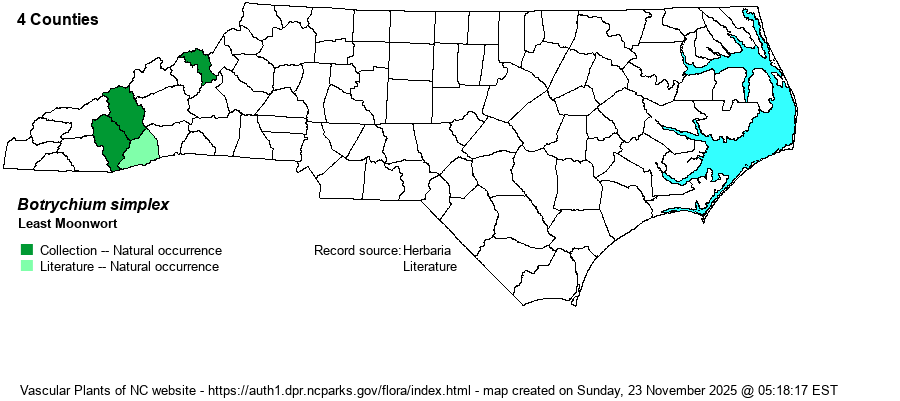| Author | E. Hitchcock | |
| Distribution | Present only in the central and southern Mountains, with specimens from three counties and an observation from one other county. Interestingly, this species and the state's other two Botrychium species -- B. angustisegmentum and B. matricariifolium -- were not known from the state when RAB (1968) was published, even though we now have about 8-12 records for each one.
This is a very wide-ranging Northern species, across Canada and south to PA, IA, NM, and CA, very sparingly southward in the Appalachians to western NC and eastern TN. | |
| Abundance | Very rare to rare in its small area in the higher mountains, with most records from along the Blue Ridge Parkway at elevations above 4500 feet; several other records are for the Roan Mountain area, which also is a high-elevation site. The NCNHP's database lists 13 records, but only four or five are fair-to-good or better in population size and quality. The State Rank has now been moved from S2 to now S1S2. This is a Significantly Rare species. | |
| Habitat | In NC, the species is found mostly in grassy places -- grassy balds, roadsides, and other places with herbaceous vegetation -- at high elevations. A few records are likely from open forests, but in general this species grows in sunny places, easily overlooked amid taller vegetation. | |
| Phenology | Fruits in May and June. | |
| Identification | This is the shortest and thus the most easily overlooked moonwort fern in the state, with the stem being barely 5-6 inches tall and quite slender as well. The stipe -- which is very thick -- is about 2 inches long, with the sterile blade barely 1.5-2 inches long and half as wide. This blade is usually pinnate, with only 2-3 pairs of pinnae on average, each pinna somewhat fan-shaped, squared or rounded at the apex. The fertile blade is very small, bead-like, and held about 2-3 inches above the sterile one, at the end of the stipe/stalk. The other two members of the genus in NC have a more dissected sterile blade, and the segments lack the rounded to fan-like form. | |
| Taxonomic Comments | Not surprisingly, owing to its very wide range, there are a few varieties, and the nominate one -- B. simplex var. simplex -- is the one found in NC.
| |
| Other Common Name(s) | Little Grapefern. Many references name this and the other two Botrychium species in NC as "grapeferns" or "grape-ferns". However, now that many of the larger, former Botrychium species have been pulled out into the genus Sceptridium, that genus contains most of the species formerly considered as "grapeferns", leaving the "new" Botrychium species better called "moonworts". | |
| State Rank | S1S2 | |
| Global Rank | G5 | |
| State Status | [SR-P] | |
| US Status | | |
| USACE-agcp | FACU link |
| USACE-emp | FACU link |

